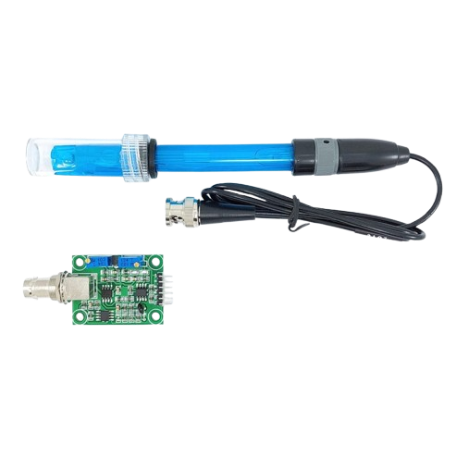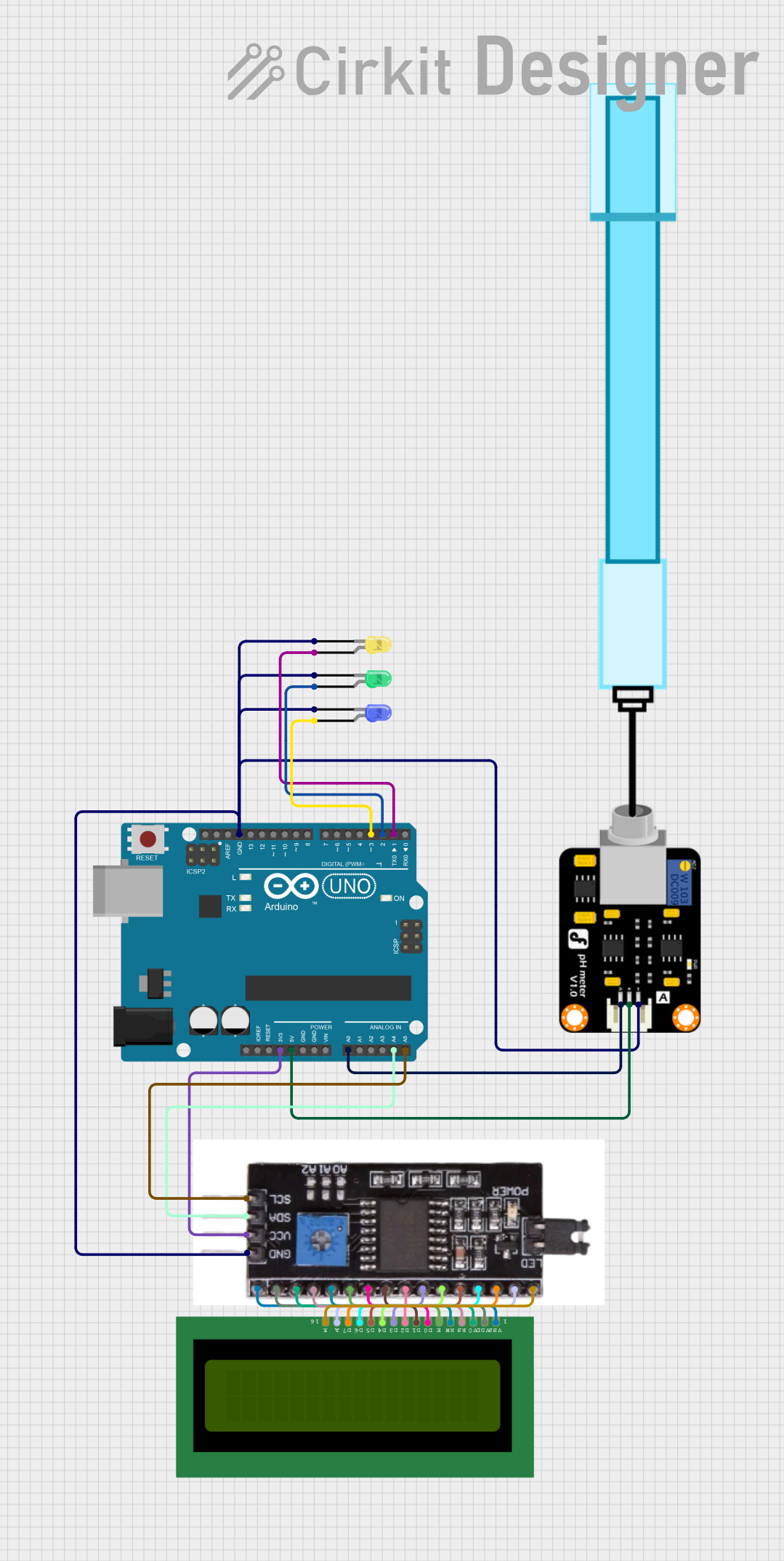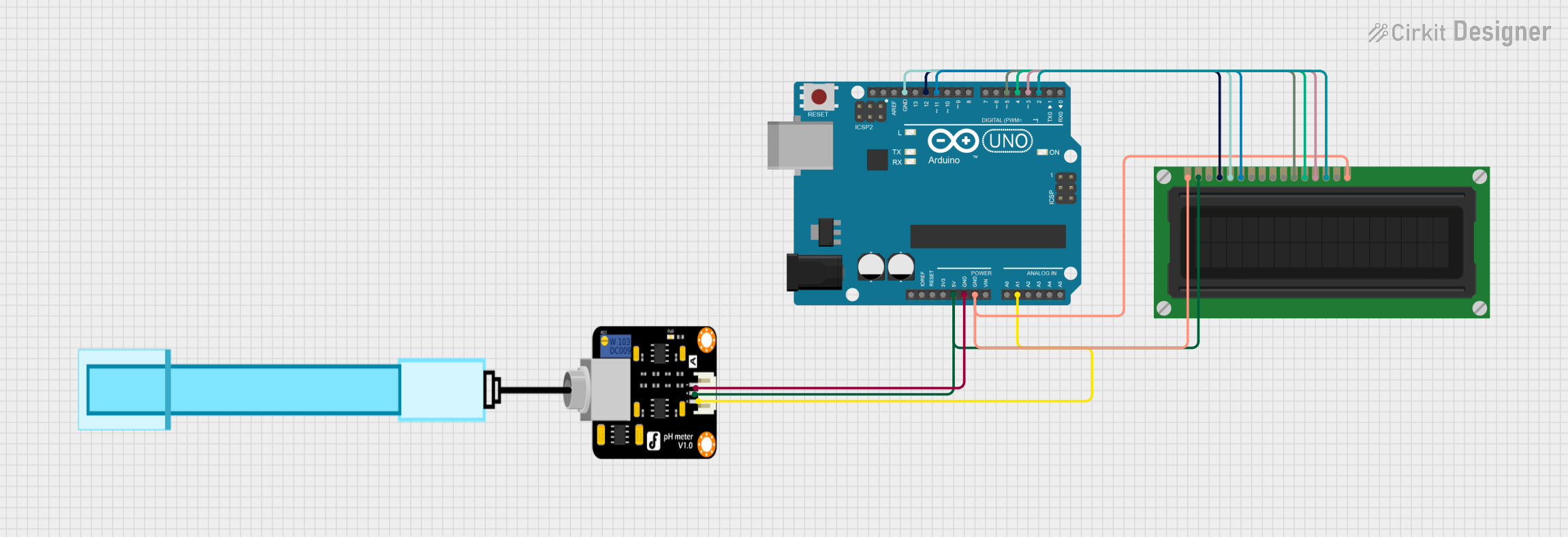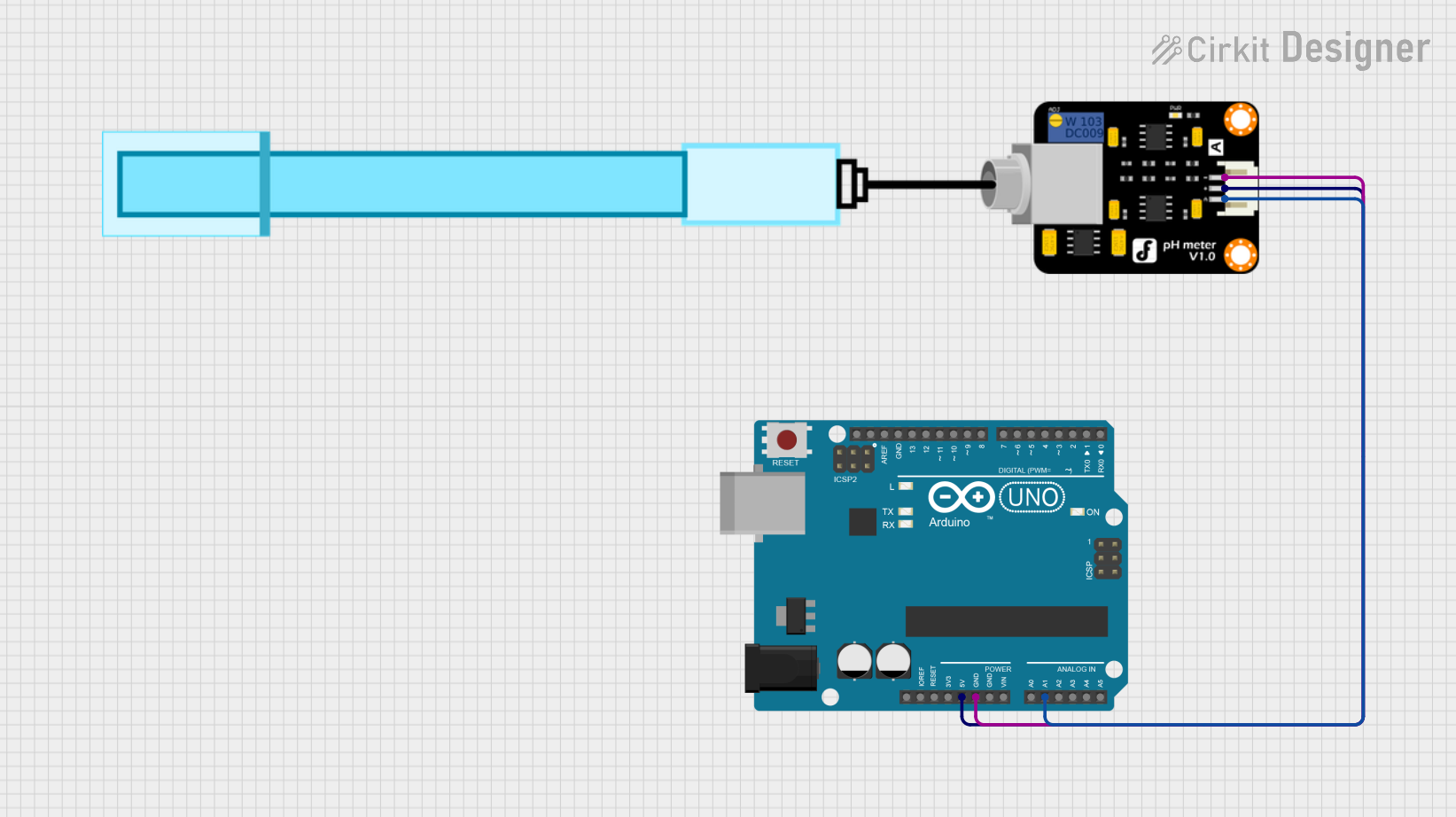
How to Use pH: Examples, Pinouts, and Specs

 Design with pH in Cirkit Designer
Design with pH in Cirkit DesignerIntroduction
The pH sensor is an electronic component designed to measure the acidity or alkalinity of a solution. It provides a quantitative representation of the hydrogen ion (H⁺) concentration, expressed as a pH value on a scale of 0 to 14. A pH value of 7 indicates neutrality, values below 7 indicate acidity, and values above 7 indicate alkalinity.
Explore Projects Built with pH

 Open Project in Cirkit Designer
Open Project in Cirkit Designer
 Open Project in Cirkit Designer
Open Project in Cirkit Designer
 Open Project in Cirkit Designer
Open Project in Cirkit Designer
 Open Project in Cirkit Designer
Open Project in Cirkit DesignerExplore Projects Built with pH

 Open Project in Cirkit Designer
Open Project in Cirkit Designer
 Open Project in Cirkit Designer
Open Project in Cirkit Designer
 Open Project in Cirkit Designer
Open Project in Cirkit Designer
 Open Project in Cirkit Designer
Open Project in Cirkit DesignerCommon Applications and Use Cases
- Water quality monitoring in aquariums, pools, and laboratories
- Soil pH measurement for agricultural purposes
- Industrial process control in chemical manufacturing
- Food and beverage quality assurance
- Environmental monitoring of natural water bodies
Technical Specifications
The following table outlines the key technical details of the pH sensor:
| Parameter | Specification |
|---|---|
| Manufacturer | pH |
| Manufacturer Part ID | pH |
| Measurement Range | 0 to 14 pH |
| Accuracy | ±0.1 pH (at 25°C) |
| Operating Temperature | 0°C to 50°C |
| Output Signal | Analog voltage (0-5V typical) |
| Power Supply Voltage | 5V DC |
| Response Time | ≤ 1 second |
| Probe Material | Glass |
| Cable Length | 1 meter |
Pin Configuration and Descriptions
The pH sensor typically comes with a BNC connector for the probe and a signal conditioning board with the following pinout:
| Pin | Name | Description |
|---|---|---|
| 1 | VCC | Power supply input (5V DC) |
| 2 | GND | Ground connection |
| 3 | Signal | Analog output signal proportional to pH value |
Usage Instructions
How to Use the pH Sensor in a Circuit
Connect the Sensor:
- Attach the pH probe to the BNC connector on the signal conditioning board.
- Connect the
VCCpin to a 5V power supply,GNDto ground, and theSignalpin to an analog input pin on your microcontroller (e.g., Arduino).
Calibrate the Sensor:
- Use standard buffer solutions (e.g., pH 4.0, pH 7.0, and pH 10.0) to calibrate the sensor.
- Adjust the potentiometer on the signal conditioning board to match the output voltage with the known pH values of the buffer solutions.
Measure pH:
- Submerge the pH probe in the solution to be tested.
- Read the analog voltage output and convert it to a pH value using the calibration data.
Important Considerations and Best Practices
- Always rinse the pH probe with distilled water before and after use to prevent contamination.
- Store the probe in a pH storage solution when not in use to maintain accuracy and prolong its lifespan.
- Avoid exposing the probe to extreme temperatures or harsh chemicals that could damage the glass electrode.
- Periodically recalibrate the sensor to ensure accurate measurements.
Example Code for Arduino UNO
Below is an example of how to interface the pH sensor with an Arduino UNO:
// Define the analog pin connected to the pH sensor
const int pH_Pin = A0;
// Calibration values (adjust based on your calibration process)
const float voltageAtNeutral = 2.5; // Voltage at pH 7.0
const float voltagePerpH = 0.18; // Voltage change per pH unit
void setup() {
Serial.begin(9600); // Initialize serial communication
pinMode(pH_Pin, INPUT); // Set the pH pin as input
}
void loop() {
// Read the analog value from the pH sensor
int sensorValue = analogRead(pH_Pin);
// Convert the analog value to voltage (assuming 5V reference)
float voltage = sensorValue * (5.0 / 1023.0);
// Calculate the pH value
float pH = 7.0 + ((voltage - voltageAtNeutral) / voltagePerpH);
// Print the pH value to the Serial Monitor
Serial.print("pH Value: ");
Serial.println(pH);
delay(1000); // Wait for 1 second before the next reading
}
Troubleshooting and FAQs
Common Issues and Solutions
Inaccurate Readings:
- Cause: The sensor is not calibrated.
- Solution: Calibrate the sensor using standard buffer solutions.
Fluctuating Output:
- Cause: Electrical noise or unstable power supply.
- Solution: Use a decoupling capacitor near the power pins and ensure a stable 5V supply.
No Output Signal:
- Cause: Loose connections or damaged probe.
- Solution: Check all connections and replace the probe if necessary.
Slow Response Time:
- Cause: Dirty or clogged probe.
- Solution: Clean the probe with a soft brush and rinse with distilled water.
FAQs
Q: How often should I calibrate the pH sensor?
A: For best results, calibrate the sensor before each use or at least once a week during regular operation.
Q: Can I use the pH sensor in high-temperature solutions?
A: No, the sensor is designed for use in solutions with temperatures between 0°C and 50°C.
Q: What should I do if the probe dries out?
A: Soak the probe in a pH storage solution for at least 24 hours before use.
Q: Can I extend the cable length of the pH probe?
A: Extending the cable may introduce noise. Use shielded cables and keep the extension as short as possible.
By following this documentation, you can effectively use the pH sensor for accurate and reliable pH measurements in various applications.